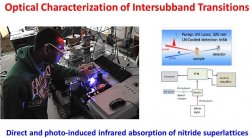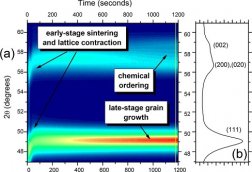 Our group's main research goal is to creatively exploit the unique properties of nanostructured materials for novel applications.
Our group's main research goal is to creatively exploit the unique properties of nanostructured materials for novel applications.
Our research has been sponsored by grants from the National Science Foundation, DARPA, and the Research Corporation for Science Advancement.
Quantum confinement in the conduction band of low-dimensional semiconductor nanostructures (i.e. quantum wells, wires, and dots) brings about fascinating optical properties in the infrared range of the spectrum. Research of these properties in recent years has resulted in fundamental discoveries that eventually triggered practical applications. Our work involves semiconductor design, materials characterization, device fabrication, and device testing.
 We are actively pursuing new light emitting mechanisms, and novel semiconductor materials such as the nitrides. Due to large electron effective mass, the nitride materials require
We are actively pursuing new light emitting mechanisms, and novel semiconductor materials such as the nitrides. Due to large electron effective mass, the nitride materials require
the ability to fine-tune the atomic structure at an unprecedented sub-nanometer level. To realize the theoretical potential of this material system, we focus on the understanding, modeling, and control of the effects of the nanostructure on optical properties and vertical transport in
nitride heterostructures. Special attention is given to the relationship between growth, structure, and optical properties in lattice-matched AlInN/GaN heterostructures.
 We are also studying the physics of quantum cascade lasers (QCLs). QCLs are semiconductor lasers that utilize optical transitions between quantized levels in the conduction band of semiconductor heterostructures to generate light in the mid– to far-infrared range of the electromagnetic spectrum. We are investigating the fundamental processes involved in charge transport and light emission in QCLs.
We are also studying the physics of quantum cascade lasers (QCLs). QCLs are semiconductor lasers that utilize optical transitions between quantized levels in the conduction band of semiconductor heterostructures to generate light in the mid– to far-infrared range of the electromagnetic spectrum. We are investigating the fundamental processes involved in charge transport and light emission in QCLs.
A second major area of research in our group involves studies of phase transformations in metallic nanoparticles. Using in-situ time-resolved synchrotron-based x-ray diffraction, we are investigating the structural properties of nanoscale catalysts as they undergo various heat treatments. We use the x-ray diffraction setup on beamline X20C at the National Synchrotron Light Source, Brookhaven National Laboratory to examine the evolution of metal nanoparticles.


 I mean, the construction is completely different, the electrolyte is different, the substrate is different. It's still a "battery," though, so it still has all those elements. I know that paper is made from wood, but that doesn't mean it IS wood. They didn't just take a carbon-zinc battery and stick a piece of wood in the middle, or between the battery and the can.
I mean, the construction is completely different, the electrolyte is different, the substrate is different. It's still a "battery," though, so it still has all those elements. I know that paper is made from wood, but that doesn't mean it IS wood. They didn't just take a carbon-zinc battery and stick a piece of wood in the middle, or between the battery and the can.



